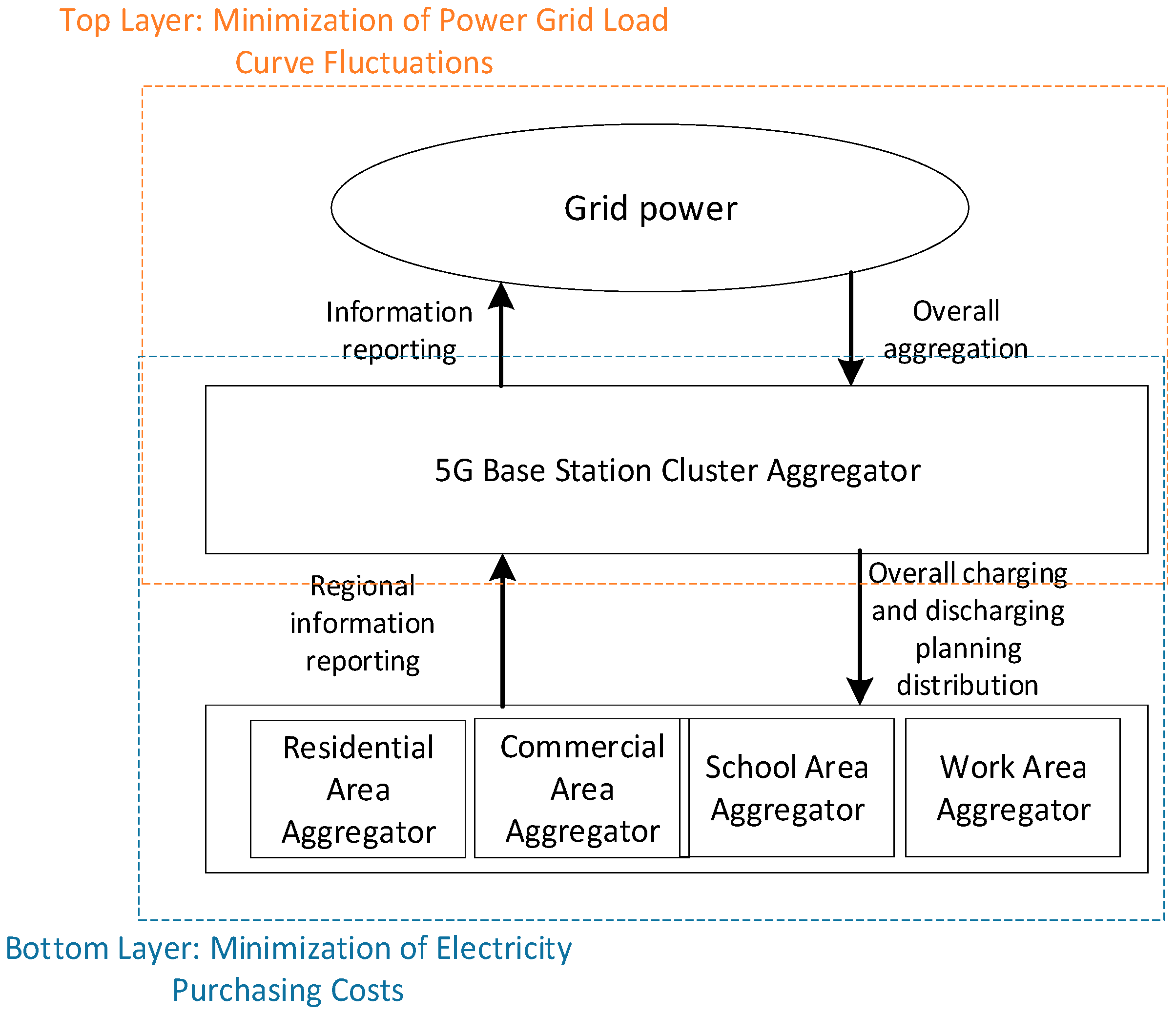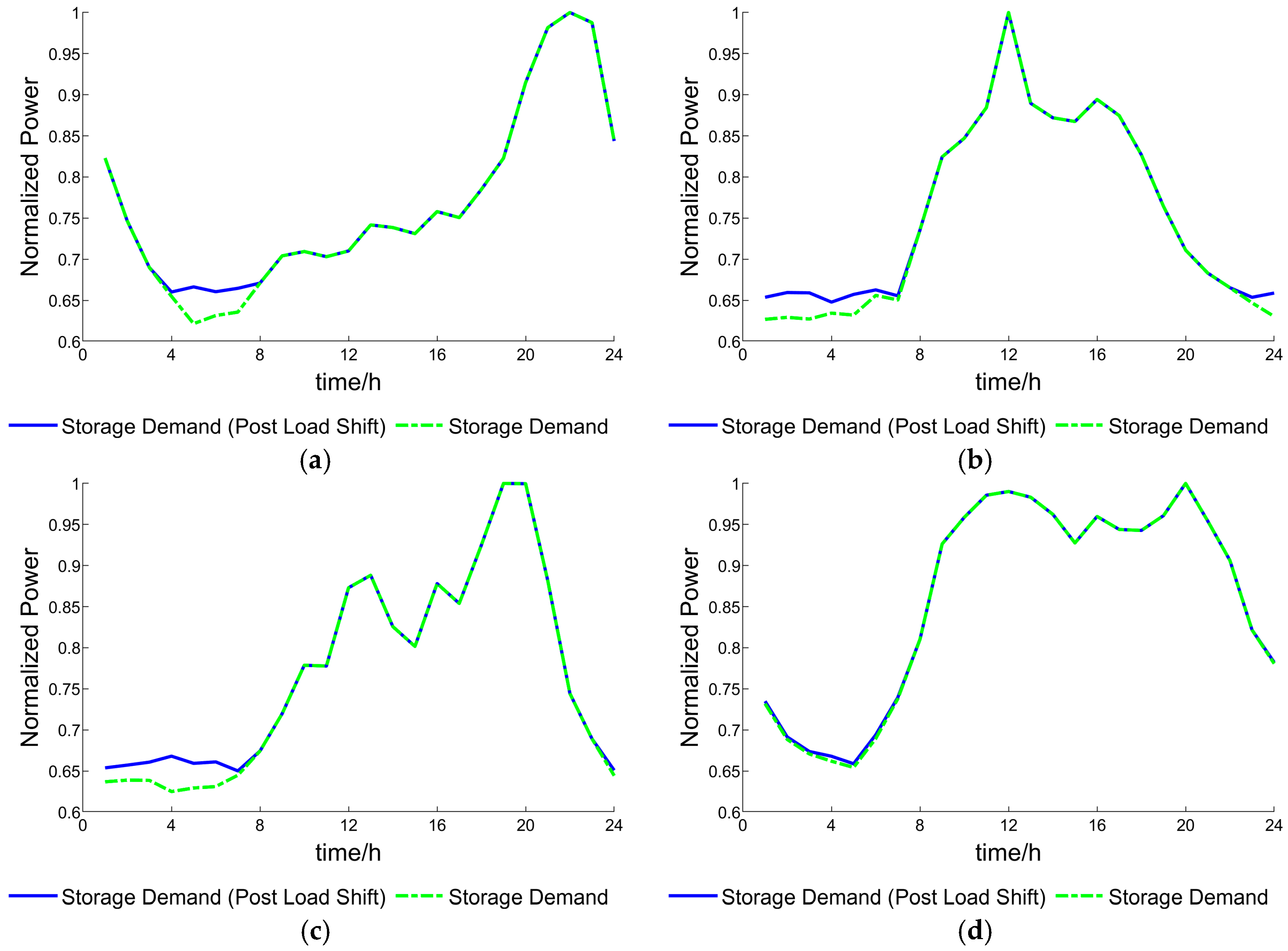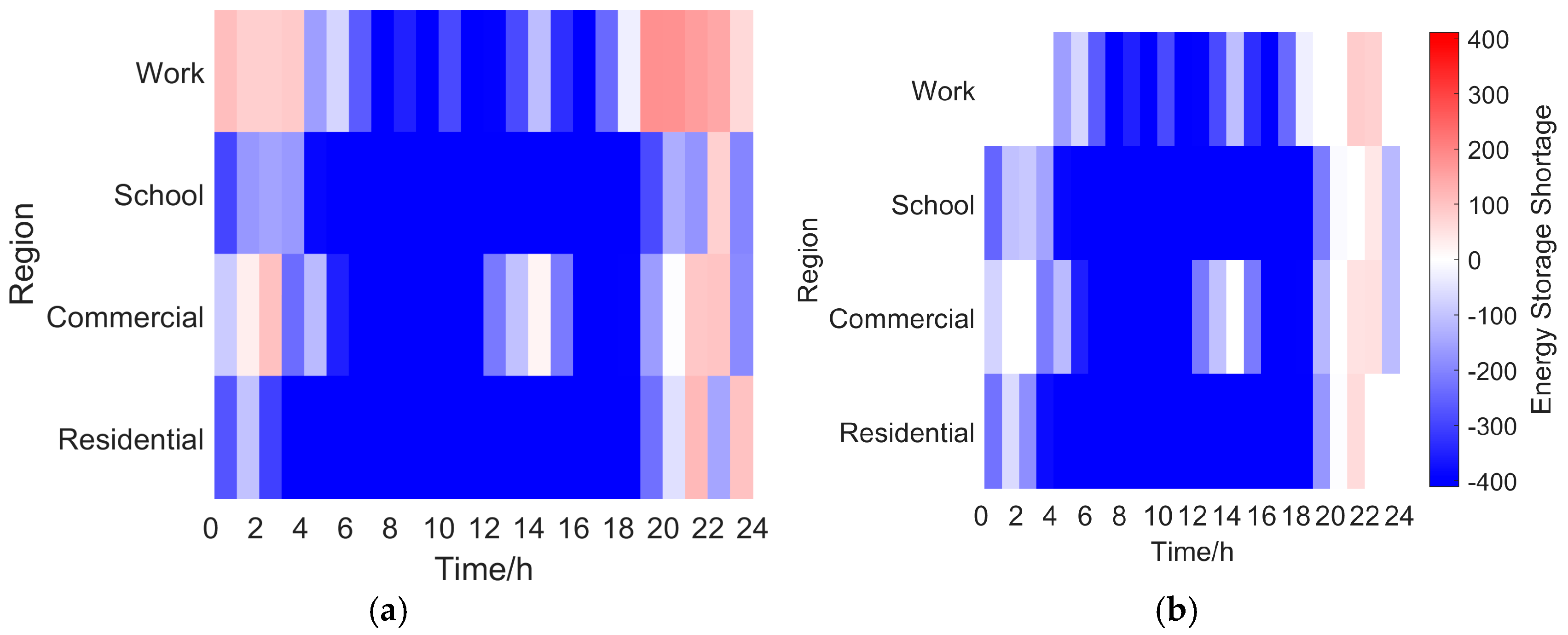A Win-Win Coordinated Scheduling Strategy Between Flexible Load Resource Operators and Smart Grid in 5G Era
Abstract
1. Introduction
- The introduction of load transfer and energy-sharing mechanisms, which significantly expand the schedulable capacity of energy storage systems by enabling flexible resource allocation across multiple regions;
- The development of a many-to-many proportional allocation algorithm, which optimizes energy distribution among 5G base station clusters and enhances the efficiency of multi-region coordination.
2. Overview of Multi-Objective Two-Layer Optimization Architecture of 5G Base Station Clusters
3. Analysis and Modeling of Scheduling Energy Storage Potential for 5G Base Stations
3.1. Analysis of Energy Storage Scheduling Potential of 5G Base Station Based on Spatio-Temporal Tidal Characteristics
3.2. Construction of a Scheduling Potential Model for 5G Base Station Units
3.2.1. Energy Storage Backup Time of 5G Base Station
3.2.2. The Real-Time Power Consumption of the 5G Base Stations
3.2.3. G Base Station Scheduling Capacity Model
3.3. Construction of the Scheduling Potential Model of 5G Base Station Cluster Based on Energy Sharing
- Determine the energy state: Based on the load and storage conditions of each region, calculate the total power demand and current storage surplus or shortage. Regions where storage capacity cannot cover upcoming standby demands are energy-scarce, while those exceeding standby demands are energy-rich. Energy-rich regions are denoted as , and energy-scarce regions are denoted as .
- Calculate the total energy surplus and power shortage. Calculate the total surplus energy and power shortage in each region, and calculate the proportion of energy surplus of each region and the proportion of energy shortage of each region . According to Equation (15), the energy transfer target is obtained as
- Construct the energy transmission matrix. To achieve optimal energy allocation, construct the energy transmission matrix and use the maximum matching rule for selective calculation. First, define the energy transmission matrix: where represents the transmission energy from the energy-rich region to the energy-scarce region . Next, perform a selective calculation: (1) Identify the region with the largest current surplus energy and the region with the largest current energy deficit. (2) Calculate the transferable energy at this moment as . (3) Update the total surplus energy and total deficit energy, and determine whether there are still energy surplus or deficit regions unprocessed. If they exist, return to step (1) and continue with the selective calculation until the energy transfer between all surplus and deficit regions is complete.
- Complete the inter-regional energy transmission. The final energy transfer matrix is the best energy transfer scheme obtained under the maximum value matching principle. After the energy transfer scheme is implemented in each functional area, the updated power is the equilibrium power realized under the scheme, so as to maximize the scheduling potential of the 5G base station cluster. The shared scheduling potential of the 5G base station cluster is expressed as follows:
4. Multi-Objective Two-Layer Optimization Scheduling Strategy for 5G Base Station Cluster
4.1. Interaction Model of 5G Base Station Cluster and Power Grid
- Cluster Aggregator energy storage charge and discharge power constraint:
- Cluster aggregator energy storage energy equation constraint:
- Cluster aggregator energy storage SOC constraints:
- Power constraints on the grid:
4.2. Energy Allocation Optimization Model for Regional Coordination
- Regional aggregator energy storage charge and discharge power constraint:
- Regional aggregator energy storage energy equation constraints:
- Regional aggregator energy storage SOC constraints:
- Overall charge and discharge power constraint:
- Charge and discharge state constraint:
5. Example and Analysis
5.1. Basic Data
5.2. Analysis of the Results
5.2.1. Analysis of Scheduling Potential of Energy Storage in 5G Base Stations
5.2.2. Optimization Scheduling Results of 5G Base Station Clusters
5.2.3. Comparison Results Under Different Methods
6. Conclusions
- The proposed method can effectively expand the upper limit of backup energy storage during the trough period. On the one hand, it can better meet the charging demand of the grid side and increase the adjustable range of the Acer station by 35.932 kW; on the other hand, the 5G micro base station enters dormancy when meeting the dormancy threshold, reducing the overall power consumption of the base station side, and the maximum energy-saving efficiency can reach 9.13%;
- The multi-objective and two-layer optimization scheduling model of the 5G base station cluster designed in this paper can well take into account the demand of peak load shifting and valley filling on the power grid side and the economy of the 5G base station side. Using the spatial and temporal complementarity of each functional region, the mechanism of energy sharing and collaborative scheduling optimization among regions is constructed, so that the 5G cluster shows the characteristics of peak discharge and trough charging, and the variance of the power grid load curve is reduced by 37.88%. At the same time, inter-regional coordination can effectively reduce the overall outsourcing power of 5G base station peak time, and obtain benefits through the low charging and high charging of energy storage, reducing the power purchase cost from CNY 4616.0 to 3024.1, realizing a win-win situation between 5G base station operators and the power grid.
Author Contributions
Funding
Data Availability Statement
Conflicts of Interest
Nomenclature
| Parameter | Description |
| i, j | Indices for micro and macro station |
| m | Indices for region |
| n | Number of base stations in a certain region |
| Number of regions | |
| Index for time | |
| Minimum standby time(s) | |
| Minimum standby time in residential areas(s) | |
| Average outage frequency | |
| Average outage duration | |
| Real-time power consumption (KW·h) | |
| Static power consumption (KW·h) | |
| Efficiency coefficient | |
| Sleep power consumption of micro base station (KW·h) | |
| Static and dynamic power consumption (KW·h) | |
| Number of macro base stations being covered | |
| Maximum loading capacity of the base station k (KW·h) | |
| Real-time function of the base station k after load transfer (KW·h) | |
| Adjustable charge and discharge capacity of the energy storage (KW) | |
| Upper and minimum capacity limit of the energy storage (KW) | |
| Energy state of the storage (KW) | |
| Charge and discharge power (KW·h) | |
| Maximum charge and discharge power limit of the energy storage battery (KW·h) | |
| Charge and discharge efficiency of energy storage | |
| Power load of the grid (KW·h) | |
| Total discharge and charge power of the 5G base station clusters (KW·h) | |
| Maximum discharge and charge power of energy storage in region (KW·h) | |
| Initial energy storage (KW) | |
| Upper and lower limits of the transmission power allowed by the grid (KW·h) | |
| Charge and discharge power rates of the energy storage participating in grid regulation (KW·h) | |
| Discharge power rate that energy storage provides for the base station load (KW·h) | |
| Discharge power rate that energy storage sells to the grid (KW·h) | |
| Time-varying purchase and sell electricity price (RMB) | |
| Loss cost coefficient of energy storage |
References
- Yang, C.; Tan, R.; He, D. Flexible Interconnection Coordinated Planning Strategy for Distribution Station Area Containing 5G Base Stations. Electr. Power Sci. Eng. 2024, 40, 33–41. [Google Scholar]
- Rawat, P.; Haddad, M.; Altman, E. Towards Efficient Disaster Management: 5G and Device to Device Communication. In Proceedings of the International Conference on Information & Communication Technologies for Disaster Management, Kyoto, Japan, 16–18 March 2016. [Google Scholar]
- Borsatti, D.; Grasselli, C.; Contoli, C.; Micciullo, L.; Spinacci, L.; Settembre, M.; Cerroni, W.; Callegati, F. Mission Critical Communications Support with 5G and Network Slicing. IEEE Trans. Netw. Serv. Manag. 2023, 20, 595–607. [Google Scholar] [CrossRef]
- Spantideas, S.T.; Giannopoulos, A.E.; Trakadas, P. Smart Mission Critical Service Management: Architecture, Deployment Options, and Experimental Results. IEEE Trans. Netw. Serv. Manag. 2025. [CrossRef]
- Li, X.; Hu, C.; Luo, S.; Lu, H.; Piao, Z.; Jing, L. Distributed hybrid-triggered observer-based secondary control of multi-bus DC microgrids over directed networks. IEEE Trans. Circuits Syst. I Regul. Pap. 2024. [Google Scholar] [CrossRef]
- Hu, Z.; Su, R.; Veerasamy, V.; Huang, L.; Ma, R. Resilient frequency regulation for microgrids under phasor measurement unit faults and communication intermittency. IEEE Trans. Ind. Inform. 2025, 21, 1941–1949. [Google Scholar] [CrossRef]
- Foresight Net. Analysis of the Market Status and Development Prospect of China’s Energy Storage Battery Industry in 2022: The Demand for 5G Base Station Backup Power Storage Will Reach 78.6 GWh. Available online: https://mp.ofweek.com/libattery/a856714352297 (accessed on 25 October 2021).
- Ma, X.; Meng, X.; Zhu, Q.; Duan, Y.; Wang, Z. Control strategy of 5G base station energy storage considering communication load. Trans. China Electrotech. Soc. 2022, 37, 2878–2887. [Google Scholar]
- Mao, A.; Zhang, L.; Sheng, Q. Research on optimal scheduling of 5G base station energy storage aggregators considering communication reliability. Trans. China Electrotech. Soc. 2023, 38, 2364–2374. [Google Scholar]
- Qiao, R.; Wang, J.; Wei, D.; Cai, C.; Shao, J.; Liu, S. Multi-time-scale optimization method for 5G base station considering backup energy storage and air-conditioning scheduling potential. Autom. Electr. Power Syst. 2023, 47, 111–120. [Google Scholar]
- Han, Z.; Wang, S.; Zhao, Q.; Zheng, Z. A capacity optimization configuration method for photovoltaic and energy storage system of 5g base station considering time-of-use electricity price. Electr. Power 2022, 55, 8–15. [Google Scholar]
- Yin, X.; Wang, Z.; Liu, Y.; Lu, Z.; Lv, G.; Pan, C. Energy storage dispatch of 5G base station energy storage for peak shaving and valley filling of distribution networks. Power Syst. Clean Energy 2024, 40, 97–102. [Google Scholar]
- Yong, P.; Zhang, N.; Hou, Q.; Liu, Y.; Teng, F.; Ci, S.; Kang, C. Evaluating the dispatchable capacity of base station backup batteries in distribution networks. IEEE Trans. Smart Grid 2021, 12, 3966–3979. [Google Scholar] [CrossRef]
- Yin, X.; Lyu, G.; Wang, Z.; Lu, Z.; Liu, Y.; Li, C.; Zhou, Z.; Ma, X. Base station energy sharing method for 5G-integrated distribution network. Mod. Electr. Power 2024, 41, 310–317. [Google Scholar]
- Wang, Y.; Yin, X.; Ou, Q.; Ma, W.; Liu, H.; Du, Z. Energy storage regulation method of base stations in 5G integrated distribution network based on energy sharing and trading coordination. Electr. Power 2023, 56, 61–70. [Google Scholar]
- Yong, P.; Zhang, N.; Ci, S.; Kang, C. 5G communication base stations participating in demand response: Key technologies and prospects. Proc. CSEE 2021, 41, 5540–5551. [Google Scholar]
- Gao, H.; Li, C.; Wang, G.; Jin, T.; Hu, J.; Zhu, J.; Chen, Q.; Kang, C. Dynamic construction and response demonstration of virtual power plant with aggregated large-scale 5G base stations. Autom. Electr. Power Syst. 2024, 48, 47–55. [Google Scholar]
- Lin, G.; Gao, C.; Song, M.; Guo, M.; Lv, R.; Fei, F. Construction and dispatch method of virtual power plant with backup energy storage in communication base stations. Autom. Electr. Power Syst. 2022, 46, 99–107. [Google Scholar]
- Ma, X.; Liu, Z.; Wang, Y.; Feng, S. Research on photovoltaic absorption capacity of 5G base station considering communication load migration and energy storage dynamic backup. Trans. China Electrotech. Soc. 2023, 38, 5832–5845. [Google Scholar]
- Rossoni, P.; Da, R.; Belati, E. Linearized AC load flow applied to analysis in electric power systems. IEEE Lat. Am. Trans. 2016, 14, 4048–4053. [Google Scholar] [CrossRef]
- Li, D. Research on Base Station Sleep Mode Technology Under 5G Dense Heterogeneous Network. Master’s Thesis, Beijing University of Posts and Telecommunications, Beijing, China, 2018. [Google Scholar]
- Al Haj Hassan, H.; Renga, D.; Meo, M.; Nuaymi, L. A novel energy model for renewable energy-enabled cellular networks providing ancillary services to the smart grid. IEEE Trans. Green Commun. Netw. 2019, 3, 381–396. [Google Scholar] [CrossRef]
- Wang, Z.; Li, Y. Micro-station sleeping algorithm based on coverage area priority in 5G network. Telecommun. Sci. 2022, 38, 88–95. [Google Scholar]
- Jang, T.; Xie, L.; Du, Y.; Ouyang, C. Dispatching strategy of energy storage for 5G base stations based on deep reinforcement learning. Autom. Electr. Power Syst. 2023, 47, 147–157. [Google Scholar]
- Zhang, W.; Zhu, T.; Su, J. Demand response strategy for power-cyber-transportation coupling network considering electric vehicles and 5G base stations. Autom. Electr. Power Syst. 2024, 48, 116–126. [Google Scholar]
- Apostolakis, K.C.; Margetis, G.; Stephanidis, C. Cloud-Native 5G Infrastructure and Network Applications (NetApps) for Public Protection and Disaster Relief: The 5G-EPICENTRE Project. In Proceedings of the 2021 European Conference on Networks and Communications and 6G Summit (EuCNC/6G Summit), Porto, Portugal, 8–11 June 2021. [Google Scholar]








| Scene | Grid Load Curve Variance 105 (kW2·h2) | Power Purchase Cost (RMB) |
|---|---|---|
| No optimization | 6.81 | 4616.0 |
| Single-Layer Direct Scheduling Strategy | 4.66 | 3466.2 |
| Multi-Objective Two-Layer Model Scheduling Strategy | 4.53 | 3024.1 |
Disclaimer/Publisher’s Note: The statements, opinions and data contained in all publications are solely those of the individual author(s) and contributor(s) and not of MDPI and/or the editor(s). MDPI and/or the editor(s) disclaim responsibility for any injury to people or property resulting from any ideas, methods, instructions or products referred to in the content. |
© 2025 by the authors. Licensee MDPI, Basel, Switzerland. This article is an open access article distributed under the terms and conditions of the Creative Commons Attribution (CC BY) license (https://creativecommons.org/licenses/by/4.0/).
Share and Cite
Zhang, N.; Liu, D.; Liu, T.; Zhang, X.; Guo, J.; Lan, F.; Li, Q.; Lu, W.; Yang, X. A Win-Win Coordinated Scheduling Strategy Between Flexible Load Resource Operators and Smart Grid in 5G Era. Energies 2025, 18, 1510. https://doi.org/10.3390/en18061510
Zhang N, Liu D, Liu T, Zhang X, Guo J, Lan F, Li Q, Lu W, Yang X. A Win-Win Coordinated Scheduling Strategy Between Flexible Load Resource Operators and Smart Grid in 5G Era. Energies. 2025; 18(6):1510. https://doi.org/10.3390/en18061510
Chicago/Turabian StyleZhang, Nan, Di Liu, Tianbao Liu, Xueyan Zhang, Jing Guo, Fusheng Lan, Qingyao Li, Weiyi Lu, and Xiaolong Yang. 2025. "A Win-Win Coordinated Scheduling Strategy Between Flexible Load Resource Operators and Smart Grid in 5G Era" Energies 18, no. 6: 1510. https://doi.org/10.3390/en18061510
APA StyleZhang, N., Liu, D., Liu, T., Zhang, X., Guo, J., Lan, F., Li, Q., Lu, W., & Yang, X. (2025). A Win-Win Coordinated Scheduling Strategy Between Flexible Load Resource Operators and Smart Grid in 5G Era. Energies, 18(6), 1510. https://doi.org/10.3390/en18061510






